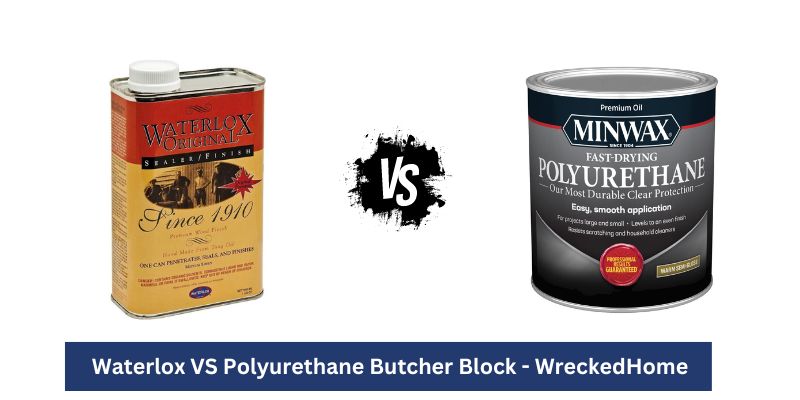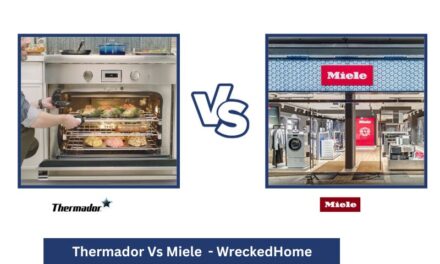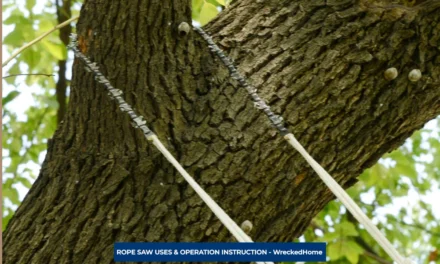Butcher blocks as dedicated kitchen countertops for cutting are common now. These butcher blocks have frequent cutting and food preparation sessions, so sealing them with a wood sealer is necessary. You have two most common wood finishing options: either use Waterlox or go for Polyurethane.
So, in this article we will cover the use of Waterlox vs Polyurethane butcher block and see possible options in these wood finishing. It will also help you learn about basics of sealants, their visual impact on the block and your kitchen, safety concerns and much more with a final verdict. So, let’s begin!
What is Waterlox?
Waterlox is one of the most popular wood finishes based on tung oil. Wood finishes often make surfaces dry or brittle, but Waterlox has an edge of resin-modified oil finishing. This oil provides the extra benefit of penetration and absorbs in the wooden surface without making any surface layer.
Similarly, the coating or Waterlox sealer on the butcher block protects the surface from cutting marks and strengthens the wood. The coating remains there without cracking or tearing off the surface.
So, your butcher block not only stays safe from the weather, but the sealing protects it from drying in a dry cooking area.
What is Polyurethane?
Polyurethane is another wood finish used to seal butcher blocks. This sealer makes a film on the countertop with a plastic-like appearance that may peel off with time. Depending on the desired look and level of protection required, you can find different types of Polyurethane wood finishes in the market. Some Polyurethane varieties are oil-based, while others are water-based.
- Oil-based Polyurethanes give wood a warm golden color, but it has higher volatile organic compounds.
- Water-based Polyurethane is similar to milk in color when it is in the can and dries to a crystal-clear finish. Additionally, this type of Polyurethane is more environmentally friendly because of its low VOCs (volatile organic compounds)
| Aspect | Waterlox | Polyurethane |
| Sealant Type | Natural oil-based, penetrates wooden pores | Forms plastic-like film on the surface |
| Care and Maintenance | Easy to maintain, smooth surface | Prone to cracks, it requires extra care |
| Visual Impact | Deep, rich finish, fine texture | Superficial texture sits on top |
| Longevity | Firm film, less chipping/cracking | More prone to damage, needs refinishing |
| Safety | Inert and safe, unlikely to be consumed | Inert but may stick to food; refinishing needed |
| Application Process | 1-2 coats, no sanding needed | Requires sanding, multi-coating process |
| Sheen Options | Gloss, Semi-gloss, Satin | Same sheen options |
| Price | Similar pricing, based on quantity | Similar pricing, based on quantity |
Waterlox VS Polyurethane Butcher Block – 5 Key Differences
Waterlox and Polyurethane are equally used wood finishes and do a great job. Still, some key differences exist in how they look, protect, and contribute to butcher block. So, if you plan to refinish your butcher block, look deeper into these key differences. You will better understand what is suitable for you:
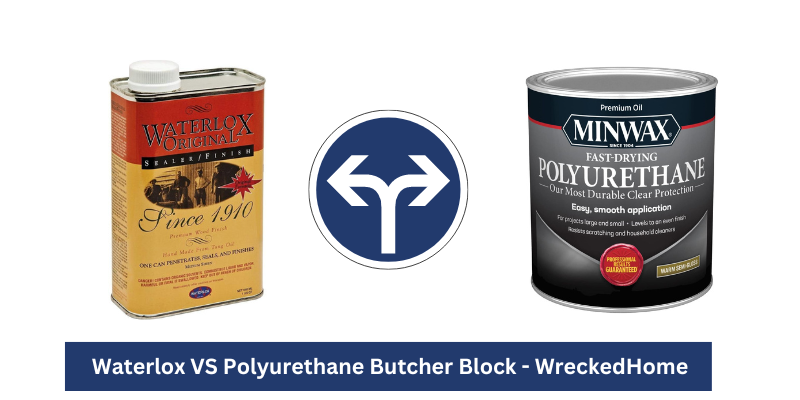
1. Sealant Type
First, before considering any other aspect of Waterlox or Polyurethane finishes, remember to consider their type. What type of material is it, and how does it contribute to your butcher block.
So, Waterlox is a natural oil-based material with more power to penetrate the wooden pores. They make a fine seal, disallowing water to seep through it. It may take a few extra coating layers, but the effort is worth it.
On the other hand, Polyurethane works differently. It does not penetrate the wooden block pores. Instead, you can see a thin film over the surface that looks like a plastic film. This wood finishing provides a barrier from moisture and prevents food particles from accumulating in the pores, but it has a downside of chipping with time.
Visit our store for 10% off our Home Maintenance products here.
2. Care and Maintenance
Taking care of Waterlox and Polyurethane butcher block is different. Blocks with Waterlox coating are easy to maintain and care for. The surface is super smooth with no cracks, and you can clean it in a single go. Polyurethane butcher blocks have a film that can cause cracks or damage at the surface. You need to invest extra time to take off accumulated food particles to make it hygienic. Otherwise, leftover food particles will invite fungus or bacteria and produce a smell.
3. Visual Impact
The butcher block outlook deeply adds to the aesthetic value of the kitchen. You cannot keep the cooking section filthy and ashy with a foul smell. So, wood finishing adds richness and warmth. But the point is whether to choose Waterlox or Polyurethane. Waterlox deeply inserts in the pores and gives a fine finish, while Polyurethane sits on the top and gives a superficial texture. So, if you need richness with fine finishing, Waterlox is your best choice.
4. Longevity
Waterlox and Polyurethane have significantly different longevity. Waterlox makes a firmly fine film on the block surface with a chance of chips or cracks. This “no cracks” feature of Waterlox increases its shelf life, as when there is no damage, there will be no need for reapplication before time.
On the contrary, solid cutting force can damage Polyurethanes’ surface earlier. This damage gradually increases in size and converts into cracks looking like peel-off paint. So, butcher blocks or countertops with Polyurethane seals need refinishing more often than Waterlox surfaces.
5. Safety Concerns
Your safety concerns about Waterlox and Polyurethane butcher blocks are valid, as your food will stay longer on the surface covered with wood finishing. Adding to your luck, both finish types are entirely safe. The materials are inert and do nothing bad if accidentally consumed with the food.
The chances of Waterlox being consumed are far less than Polyurethane as it tightly sticks to the surface with no possibility of ripping. Polyurethane may give you a tough time and stick to your food, giving an unpleasant experience. But this is nothing to worry about. Just refinish it for your satisfaction.
6. Application Procedure
Correct application of wood sealers is vital to get maximum advantage, and both have a bit different procedures. Tung oil-based Waterlox sealer seals the wood from the pores. One to two coats are required (depending upon the hardness of the wood) for adequate film build-up. Additionally, there is no need for sanding or multi-layering. A single coat will be enough to make a fine, water-resistant film.
On the other hand, Polyurethane coating is comparatively laborious and time-consuming. You need to sand and clean the surface before application. Sanding is done in the direction of the grain with an electric oscillating sander. You can begin with 120-grit sanding discs and progress to 220 and 330-grit papers for fine finishing. After that, apply the first coat all over the surface and blend naturally. Next, let it dry. Depending on the temperature and humidity, it may take 2 to 3 hours. Once it is dry, apply a second coat and wait until dry. Your job will be done with a fine sealed surface.
7. Sheen Availability
Sheen of the butcher block means how it will look after wood finish. You may call it shade or color of the block surface and you can have it in gloss, semi-gloss, and satin sheen. The availability of these sheens makes color combination easy. For instance, if your kitchen is on glossy theme, you can easy select glossy sheen of these wood finishes. Same is the case with others. So, this selection makes theme building stress-free and practical.
8. Price
The price of Waterlox and Polyurethane are almost the same with no considerable difference. You can find different a quantity of these wood finishes in different packages but overall they cost the same. On average, one quart of Waterlox will cost you $45 while same quantity of Polyurethane can take around $50. So, it is confirmed that price is not the deciding factor. You can make a decision depending on your choice or desired color scheme.
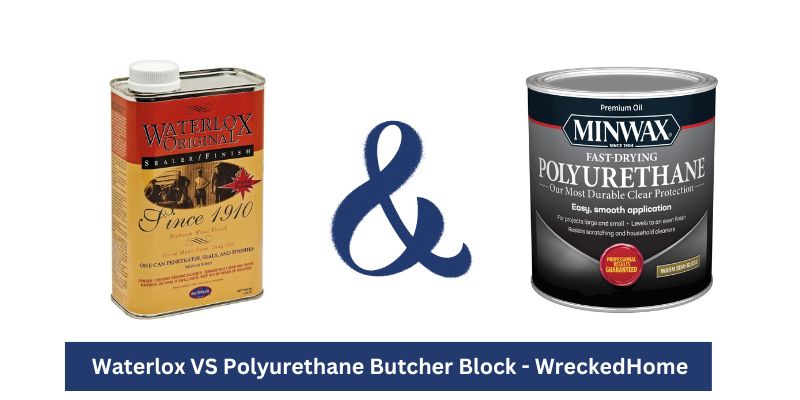
Waterlox vs. Polyurethane – What’s the Best?
After comparing all qualities of Waterlox and Polyurethane, now is the time to find the best. So, we found that Waterlox has more quality features than Polyurethane. It has natural origin and easy to care for. Similarly, it gives no harm to the butcher surface and is free from the risk of wear and tear. All you need is to apply on the surface and you are good to go for years. Neither will it peel off, nor will crack and one time seal will easily last for 5 to 10 years. Some homeowners even have it for more time. So, it will not be wrong to say that Waterlox is one of the best butcher block sealers.
Can you put Polyurethane over Waterlox?
Polyurethane and Waterlox are two entirely different wood finishes. You cannot apply one on another. If your butcher block is already covered with Waterlox and you want a new layer of Polyurethane on it – then it will not work.
This is because of less sticky nature of Polyurethane and it will not stick to already coated surface.
In the reverse scenario, you can apply Waterlox on the block covered with Polyurethane. The binding power of Waterlox is far more than Polyurethane that will help make a seal.
Conclusion – Watelox vs. Polyurethane
After getting everything about Waterlox vs. Polyurethane, you better understand which one is best for you. Just make an informed decision after reading everything and cover your butcher block with the sealer to prevent water and cutting damage. Smoothly covered butcher block not only adds aesthetic value but also make your kitchen nook welcoming.
For any repairs, installations, builds, or questions; We recommend you to hire a professional. Find A Pro Near You Here!

